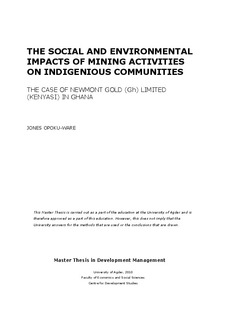| dc.contributor.author | Opoku-Ware, Jones | |
| dc.date.accessioned | 2010-09-21T08:27:05Z | |
| dc.date.available | 2010-09-21T08:27:05Z | |
| dc.date.issued | 2010 | |
| dc.identifier.uri | http://hdl.handle.net/11250/135149 | |
| dc.description | Masteroppgave i development management- Universitetet i Agder 2010 | en_US |
| dc.description.abstract | The study explores and assesses mining and its impacts on communities within which
mining activities takes place. The focus has been on a mining community in Ghana called
Kenyasi where mining is vigorously carried out by an American mining giant, Newmont
Mining Corporation. The study investigates the real and latent impacts of mining activities
on the community in the light of the numerous promises and prospects that mining is said
to provide for communities.
Mining for many decades served as an important component of countries‟ revenue source
especially for developing countries that have been endowed with the mineral wealth. If
properly managed, countries can grow their economies with proceeds from mining
activities in the form of royalties and foreign exchange earnings for the export of mineral
related products. Such benefits from the mining sector have in most cases been used as
justification and a social license for exploration and exploitation of minerals in most
communities.
Nonetheless, in as much as the mining sector have contributed and continually contributes
to the economies of mineral endowed countries, one cannot lose sight of the fact that the
very nature of mining itself in terms of the lifecycle of mining from discovery to closure
seriously impacts on the lives of the communities in which it is undertaken. From the
prospecting stages through the construction of mining infrastructure and the actual mining
itself carries diverse impacts on communities that can very devastating on the one hand and
developmental on the other hand. Usually the impacts are environmental and social in
nature and it is these impacts, real or imagined that this study sought to unravel.
The environmental and social impacts can to a larger extent change the dynamics of
community living and can make the lives of its residents better or worse. The way these
impacts are managed by the communities and the mining company involved can either
further worsen or make lives rather better for the community and its residents. This calls
for drastic attention being paid to issues of Corporate Social Responsibility where mining
companies make great efforts in honouring its social obligations to the communities of
operation. One way has been the development of Alternative Livelihood Strategies or
Coping Mechanisms by mining companies with the view to cushioning people from the
adverse impacts of their mining activities as it is done in Kenyasi by Newmont Mining
Company and even the community residents themselves. Although most mining companies
have carried out these strategies with good intent, it has been realized that mostly, the
strategies fail because they lack what has come to be known as Community Participation.
The study has paid particular attention to this issue of Community Participation and how its
application to the various impact management strategies devised by Newmont in particular
as a corporate entity has helped in managing the social and environmental impacts of
mining in Kenyasi. | en_US |
| dc.language.iso | dut | en_US |
| dc.publisher | Universitetet i Agder, University of Agder | en_US |
| dc.subject.classification | UT 503 | |
| dc.title | The social and environmental impacts of mining activitieson indigenious communities : the case of Newmont Gold (Gh) limited (Kenyasi) in Ghana | en_US |
| dc.type | Master thesis | en_US |
| dc.subject.nsi | VDP::Social science: 200::Demography: 300 | en_US |
| dc.source.pagenumber | 139 s. | en_US |
